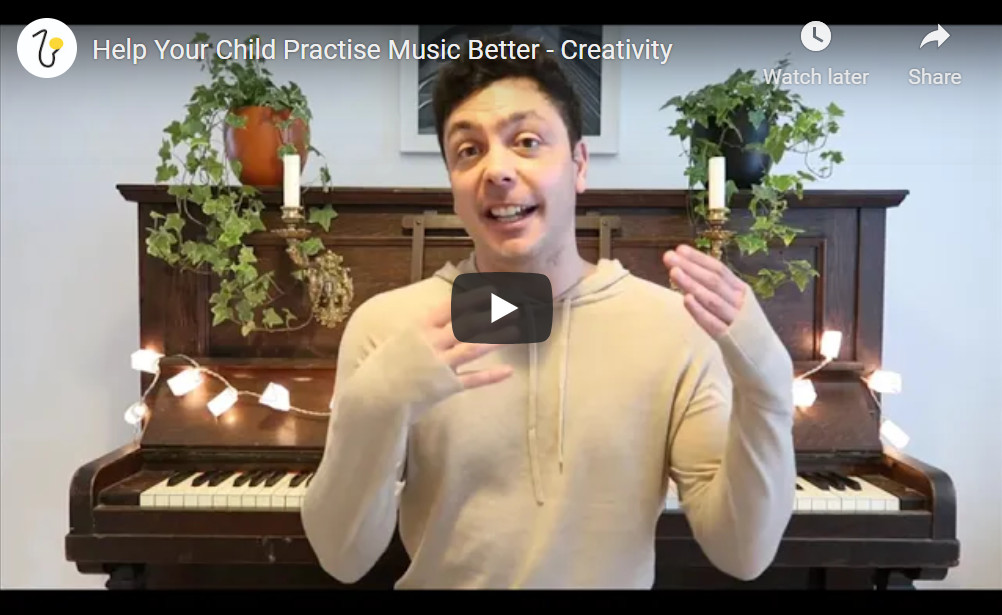Welcome to this new tutorial series on how to help your child practise music more effectively without the need for musical knowledge or experience. Today's short video is on the subject of Creativity in Practise - the most important thing at ANY level.
Children are naturally imaginative and creative! This short video will give you some ideas about how to use this natural asset to help your child practise more efficiently, improve faster, and have fun while doing it.
Introduction
It's a pretty simple equation! Children who enjoy practising want to do it, and the more they want to practise, the better they get! The key thing to remember is that just like performing, practsing music should be play, not work.
Of course, there has to be an element of practising that focuses on improving technique, but overfocussing on this can make practising a negative experience for a child. Even if you don't have musical knowledge yourself, there are many ways to help support your child's practise that focus on creativity rather than accuracy. Here are few simple ideas on how to help your child develop a positive musician's mindset when practising and focus less on getting things 'right.'
Generating Excitement!
Try to approach each practise session as an exciting new experience! In my teaching I'm always looking for new ways to explore the elements of the music and how it feels to play it. If you're not a musician yourself this is still possible. Ask your child to describe how it feels to play the music. What are the challenges, what are the easy bits? What are the sensations of playing this or that particular note.
New opportunities and experiences don't have to be limited to playing on the instrument. For phrases and notes that your child finds easy to play, try getting her or him to clap or sing the song, or pdance it expressively with their body!
Get involved, join in and don't be afraid to get silly! Developing a stronger emotional connection to playing music through these kind of experiences is a vital part of getting your child to want to practise.
Maintaining Interest
For children, learning a piece of music, easy or difficult has several stages both practically and mentally. Once a child can play a piece of music well, it's easy to just move on to the next challenge, this is a great opportunity for creativity and exploration. Now the really important creative practise can begin.
There are many ways to have fun and express oneself with a familiar piece of music. Why not try exploring and improvising with some of the below ideas:
Play with Tempo
Getting your child to play in time can be very challenging and should be carefully maintained, but that's no reason not to allow your child to have a little fun playing with the speed of the music. Try playing slooooowwww, fast, or speeding up and slowing down in unusual or interesting parts of the song.
Vary Volumes
Playing with volume (dynamics) is a great way to develop shape or structure in a piece of music. It's likely your child's piece has dynamics in there already, but why not let them express themselves and create a new narrative for the piece of music. Sudden changes in volume can be fun and create great opportunities for enjoying the practise together
Be Imaginative!
Creating and setting a mood is a vital musical skill, and is also a great opportunity for creativity and improvisation. Discuss your child's piece with them. What mood does it set? Does it bring a particular image, idea, scene or feeling to mind? Get your child to describe this in detail and imagine it as an accompaniment to the music. Try asking them to play the piece while imagining a scene from their creation and enjoy the difference it makes to the quality of their playing.
Practise Feelings as well as the Instrument
The main aim of practising is to improve, which can happen directly or indirectly. When we practise we are basically establishing habits - patterns of movement or behaviour that become familiar over time. Don't forget how you feel when you practise also becomes internalised and habitualised, so it's vital for your child to practise with a sense of excitement, happiness and self-expression, and avoid feelings of boredom and resentment.
Round Up
In summary, keep each practise session fresh, exciting and unique! Be as creative as possible and allow your child's natural curiosity and imagination to direct the learning!
If you've enjoyed this tutorial please Subscribe to the Sax Teacher UK Channel. See you soon!
